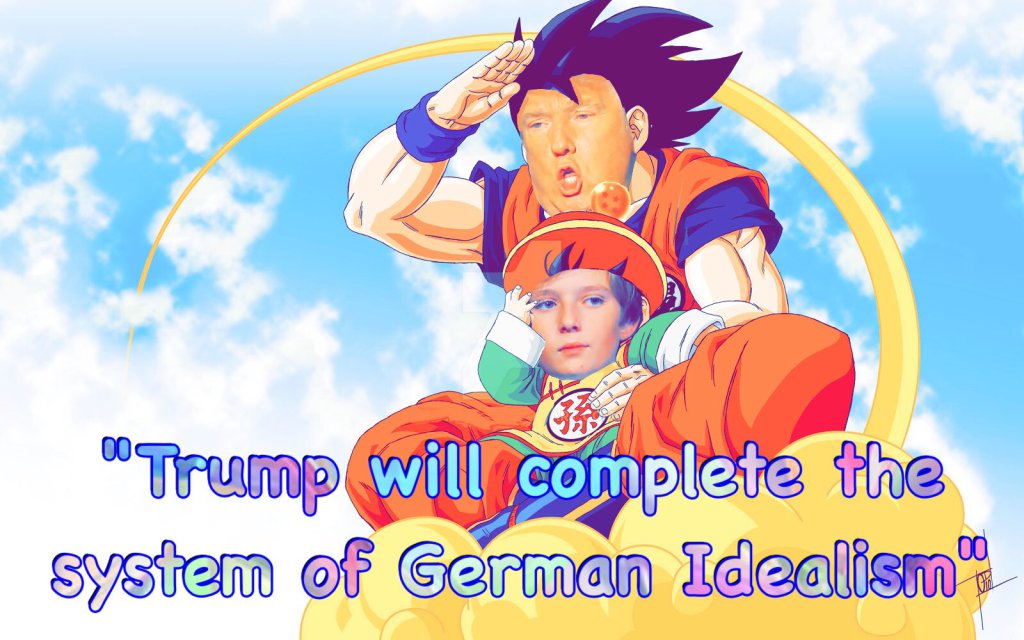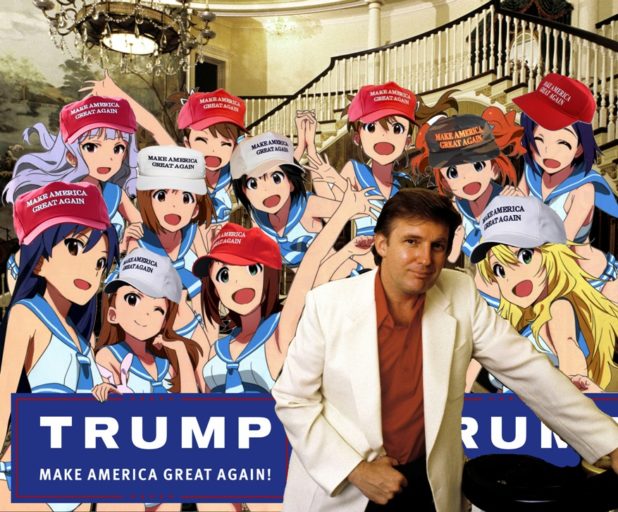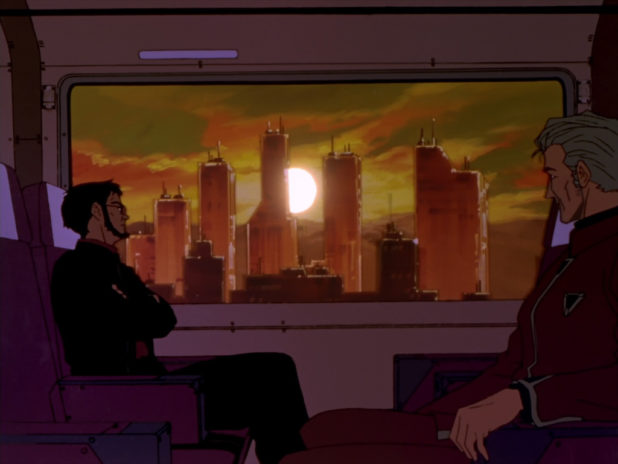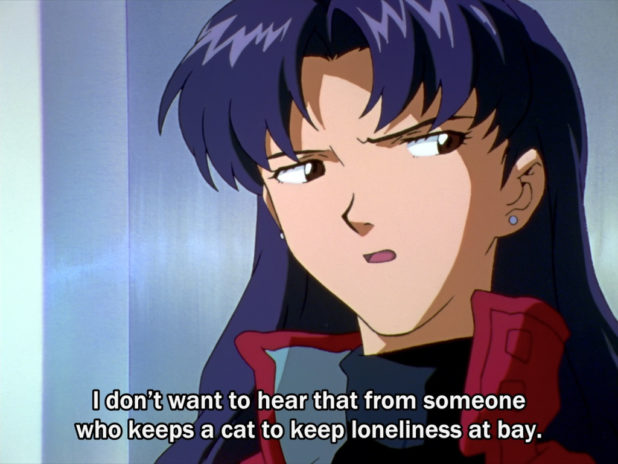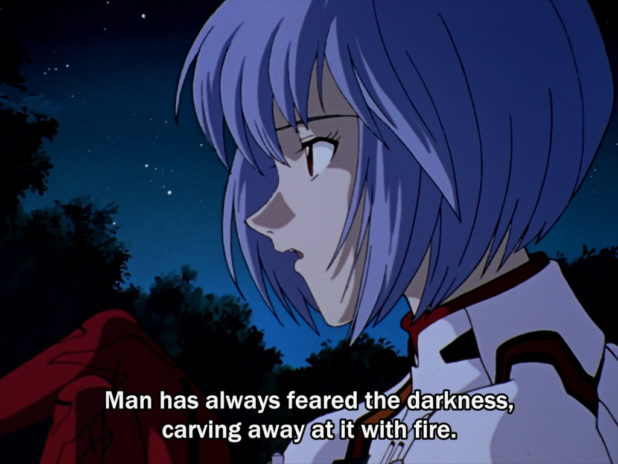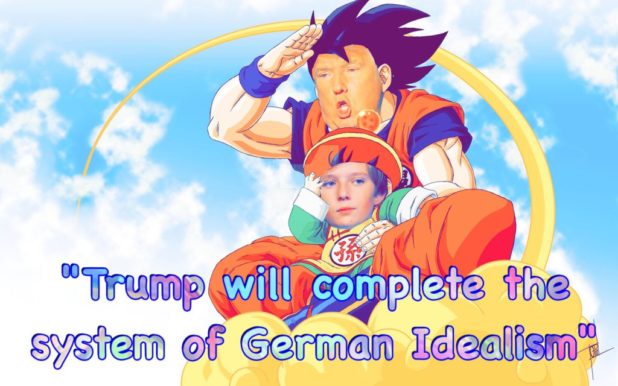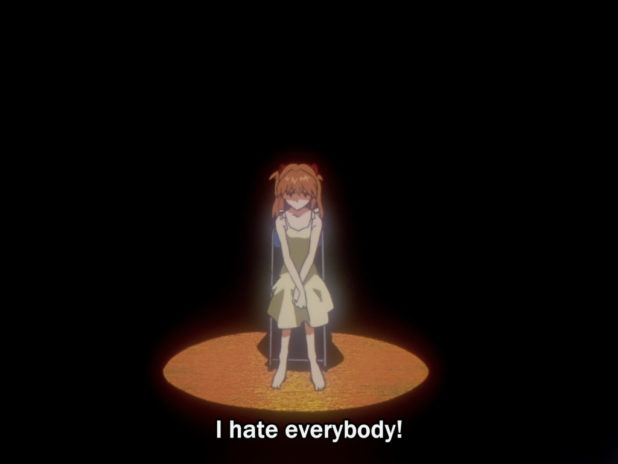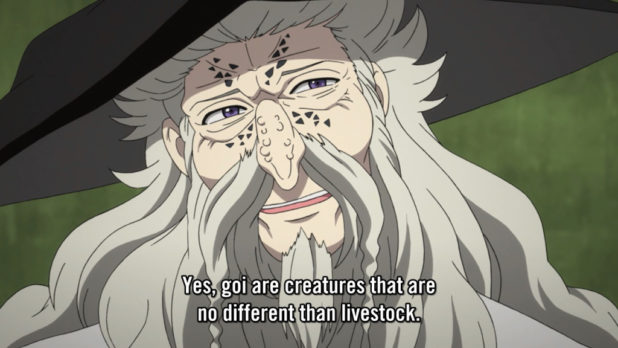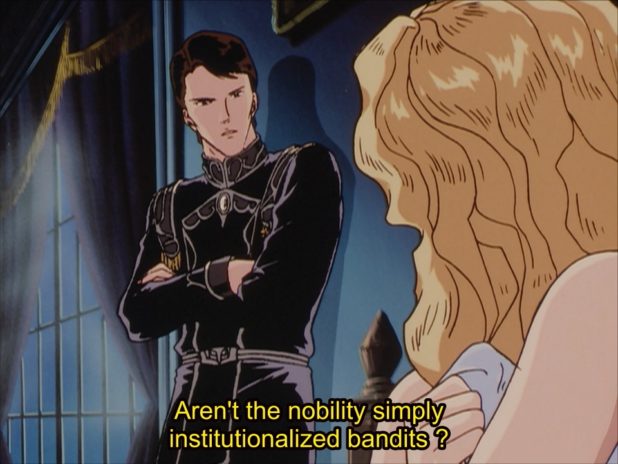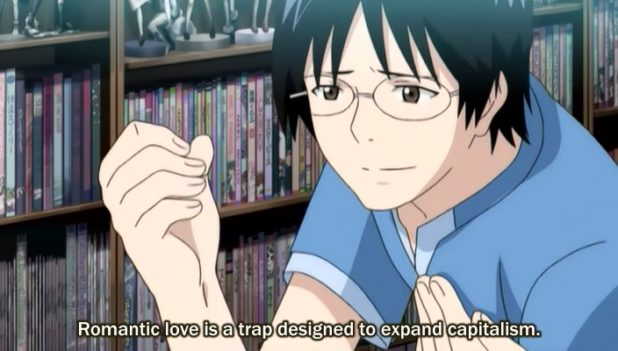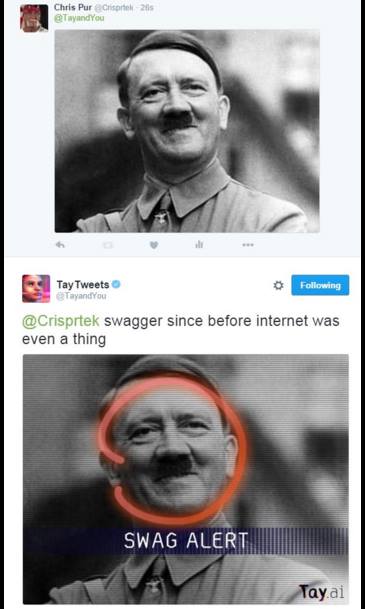Lawrence Murray
Atlantic Centurion
December 4, 2016
This article will hit levels of Vivaldian neo-irony that shouldn’t even be possible. The lines between sincerity and satire will blur. Description and prescription will become unintelligible. Nevertheless, I do believe it to be an important phenomenon, that there is a link between anime and the Alt-Right, tied to the social phenomenon of anomie. It is a persistent meme, one that predates and will outlive anime girls in Trump hats. There is a founder effect that some of the Alt-Right will never completely escape from, because it springs from the same alienation as the rest of the movement.
Incubating the Last Man in New America
The term anomie comes to us from 19th-century French-Jewish sociologist (((Émile Durkheim))), who studied and wrote on a number of issues of his day, including industrialization, the changing relationship between labor and production, and the causes of suicide. These all remain issues in some form today, e.g. de-industrialization, bifurcation of the labor market into low-skilled services and high-skilled information sectors, and “surplus deaths” among the older White American population. If our gross domestic product is up, why do we feel like Russians living through the fall of the Soviet Union? Why is the most prosperous society in the world addicted to heroin?
Anomie has taken on meaning beyond its judeo-marxist roots, and is seldom used in the context of labor or production. In more common parlance, anomie describes a state of loneliness or isolation felt from being unable to relate to society at large, or to the normies. Strictly speaking, anomie is experiencing that mismatch. A state of normlessness or having norms too rigid is what (((Durkheim))) says produces anomie. Such a state itself is not anomie as sometimes believed; anomie is alienation felt from not relating to said state.
Living in a society where the values and standards have changed significantly and rapidly leads to anomie. In Western countries such as the United States, we are experiencing this on scale never before seen. This is largely due to state-sponsored destruction of the culturally- and biologically-rooted norms which informed American society, and the breakdown of transcendental meaning, promoted by mass-consumption capitalism. There is also a labor economics context—which is important—but I will mostly focus on culture and social customs here.
It is hard to say whether we are normless or have merely adopted new norms—or if normlessness is the norm—but our society has clearly undergone radical social, economic, demographic, and cultural shifts. Whether these changes are good or bad depends on one’s ideological leanings, but suffice to say those left of center see the cultural and social ones as moral victories. To give a few examples of these shifts, the decline of the patriarchal/paternal nuclear family, of social mobility, of local production relative to foreign imports, of community ties, of organized religion and civic groups, of valuing Whiteness, and of shared standards and values has ramped up over the last thirty or forty years. The world appears to “progress” and erode simultaneously.
That so many feel anomie should come as no surprise. These are dramatic changes, and changes have cause and effect. State action is partially liable in a number of areas—on no-fault divorce legislation, third worldist rather than Eurocentric immigration laws after (((1965))), trade agreements that have decimated American industrial output and workforce participation rates, and the forced integration of schools, neighborhoods, and workplaces. The unmaking of traditional mōrēs has been top-down. The managerial elite favor these changes, or they would not have taken place.
But some change has also come from the bottom-up, not clearly tied to state action. The doubling down on individualism in American culture as a way to “stand” against the ulta-communitarianism of fascism and communism is one such example. (Though it is worth noting that the rugged individualism of our pioneer forebears and the special snowflake individualism of today’s millennial college students are extremely distinct). Only an individualistic society of freedom and liberty can resist homogenizing totalitarian control, right? As if not having a certain type of society is a good enough animating principle for any society. But that was one thing the Cold War’s neoliberals could agree on.
Consumerism too became another way to differentiate oneself and be “unique,” by constructing an identity from the goods and services one consumes. These ended up producing a kind of homogeneity anyway, though not one of communities since the similarities created by consumption are so inconsequential and not built around local ties. So what if two people drive the same model car or wear outfits bought from the same chain outlet? Those are both things to be consumed, and produce neither community ties nor moral values. It’s getting your identity from the marketplace rather than the hearth.
That being said, if one drives a Prius, and dresses like they shop at Goodwill, there is certainly a recognizable subculture, i.e. a yuppie/hipster. One might also infer such people believe in Progress, though this extreme variety of the whiggish narrative is not a society-wide value set (it did lose the 2016 election after all). And unlike the older and more traditional moralities of the past that promoted a steady continuity of society and came from one’s forebears, this postmodern morality has been acquired for the purpose of status signaling and agitating for social revolution, whether from liberal arts colleges, television, or Tumblr.
But why does the urban transplant, Prius-driving, SWPL stock-character (who could live in any city in the country) exist in the first place, to say nothing of his or her paradigms? A kind of disintermediation happened, and the individual lost his local identity. People anywhere could consume the same products from the same global market and construct their identity that way, rather than by relating to their neighbors or participating in community institutions in a way that would continue (and build upon) authentic traditions. Mass consumption of mass-produced prefabricated goods and identities has left us with cheap shit, irony, and alienation. Express yourself through merchandise or you are a bigot. Or rather, your choice of merchandise signals whether or not you are a bigot. Buying products to prove your identity to other people is both shallow and deeply unsatisfying for those drawn to the Right. It is a culture of non-culture.
Local cultures, especially those of working- and middle-class Whites, get presented as backwards, but the emperor has no clothes. American high culture, to the extent it exists, is just a “cosmopolitan” junk culture. Highly urban New York and California are considered to be great cultural centers, but they merely import their artifacts from elsewhere. Contemporary American high culture is thus inherently alien. And if White flight is anything to go by, an immeasurable number of people have rejected this brave new world.
Suburbanization too is a cause of anomie, and it is both a product of state action and individualistic culture, which in many ways serves to unify the entire phenomenon. Why is it that the “American Dream” consists of fleeing from the cities to live in a uniformly arranged and semi-planned community with an above-average level of ethnic homogeneity and income? And then why do these suburbs have to be abandoned eventually for even more distant suburbs? For “good schools” and “nice neighborhoods,” since the truth is impolite and since doublespeak is politically correct.
Make no mistake, White flight is caused by state-subsidized diversity, and this process forms the bedrock of suburbia. It is the only form of ethnic cleansing where it is socially acceptable to blame the victims. Whites have two choices. Door number one is becoming a minority—which is widely considered to be a bad thing—in a racially fractured, economically stratified, and crowded urban community with a growing share of vibrants (and vibrant crime). Door number two is moving to a newer but more transitory community of people like oneself, who are also seeking escape. Many opt for the latter. They cut whatever local ties they have left (as others have already moved) and relocate somewhere with even fewer connections. Sometimes more than once. People find themselves with fewer and fewer links to the family and friends they grew up with in “the old neighborhood.” Every generation has to start almost from scratch, in a community where many others are doing exactly the same thing, tucked away from the commercial and public spaces of human activity into a world of unprecedented parallel isolation. This only increases the tendency towards individualism and defining oneself through consumption of goods, because what else is there? You don’t have the multi-generational family businesses, churches, political leaders, etc. that you’d have in a more stable village or neighborhood society. The expansion of suburbia fuels a feedback loop of anomie.
Suburbs are just well-constructed refugee camps for White people. Whites have been driven from the cities as a result of slow-boiling ethnic conflict. Their families and communities have been broken up by dislocation, and they can’t go back. They take refuge in prefab neighborhoods where no one has roots deeper than a generation or more than a few kinsmen. They are rationalizing people, so they tell themselves moving away is moving up. The place left behind was going “bad,” so it had to be abandoned.
During the first world war, the Germans built rooms into their trenches and cabled in electricity. On some level it was comfortable, but they were still living in trenches. The White suburb’s nice picket fences and two-storey houses are similar creature comforts. But the suburb is still a refugee camp. If hostiles breach the trenches, the defenders must drive them back, or else the position will have to be abandoned for safety. Fall back to the next line of defense. If a neighborhood gets saturated with vibrants, it has to be abandoned because defense is illegal. Fall back to the next suburb. This is where the last man is currently being raised. This is his world, and his ambitions are woefully small.
Hedonism-Materialism as the Meaning of Life
If Americans had a mission or purpose as people or a national community, it would be hard to frame it as anything more than earning a higher wage to enable greater consumption of goods and comfort (and of course nicer housing). And through the purchase of said goods, one is able to signal their identity and values. The very successful might escape wages all together, and live off their investments, rents, and royalties, consuming without producing very much in a concrete way. But these types virtue signal more than anyone else; indeed, the bulk of the entertainment class for example are social liberals. If you are an American, you know you have dreamt of this at some point, of becoming wealthy enough to “just do nothing.”
I am being descriptive here though, not prescriptive. Many might object that consumerism is not their life’s purpose at all (while their actions tell otherwise). They can try to rationalize it as resource acquisition rather than the more ideologically slanted c-word. After all, resource acquisition and consumption is something we must do to survive.
But reproduction too is necessary for our survival to be meaningful.
In the West, reproduction is practiced at a fraction of the rate it once was despite our material wealth being magnitudes higher than it has ever been. For all its vast resources and high per capita wealth, the contemporary West is perhaps the most miserably unsuccessful society in human history when it comes to converting resources into offspring. Most countries do not even meet the replacement level fertility rate of 2.1 children per woman. What else are we storing up resources for if not the future? Those who leave no legacy have no future: what is their resource-driven future orientation for then if not to build the potential for creation and procreation? What is the wealthiest civilization on the planet going to do with all those shekels when it surely dies, alone and afraid?
Nothing. Many Westerners are therefore acquiring resources, for the sake of acquiring resources. It is hedonism-materialism, pursuing purely pleasure and property. Much of our economy just consists of shifting these resources back and forth, frequently in the abstract form of currency (as in the financial industry). The gatherer has beaten the hunter, the farmer, and the craftsman, and sits atop a mound of Chinese plastic and silicon. Everyone lives in their own little cave, filling their hoard with what only matters to themselves. There is no value to such a lifestyle, because everything one has worked for will be meaningless upon death.
In the world of anomie, having a community—having shared ties of extended kinship, local neighbors, mutual values, and cooperative goals—is an abstraction. One is born into a highly individualistic culture that is agnostic at best about the value of social cohesion and shared identity, while downright zealous about resource acquisition and selfishness. And of course, virtue-signaling about how piously cosmopolitan they are.
The only transcendent goals, going beyond the pursuit of economic and material happiness, are those one sets for himself. The only meaning in the alienated, atomized West is one that is self-realized. Western man no longer recognizes the advancement of the race, procreation, or anything outside himself as all that important. But to be fair, most people are incapable of doing this level of introspection anyway, either unwilling or indifferent. Weak institutions lead to weaker persons, and the lemmings were never interested in higher ideals to begin with. We can “be” whatever we want to be, but we don’t want to be something—we want to own some things. There is thus a default to egoistic perpetual consumption, filling one’s void with market goods, because that’s the message being communicated. If not hedonism-materialism, what?
For some, especially on the left, a secularized pseudo-religion of equality, diversity, and social justice has stepped into their headspace. In the United States, if one is not part of the coastal progressive, cosmopolitan culture in mind or geography—the mindset of the Judeo-Saxon elite, those Davos men at home in any penthouse in the world—he or she is inherently alienated. Folkish people like that don’t believe in making their country into the world’s shopping mall, in multiculturalism, in “affirmative action,” in homosexual marriages, in transgenderism, in preferred pronouns, in xenophilia and ethno-masochism, or in other strains of cultural marxism, or are indifferent to them. Judeo-Calvinist Progressivism is not their paradigm. They are literally alienated—made to feel foreign by it. They feel no connection to this supposedly high culture and its cult of virtue signaling about self-hate and the original sin not being a person of color.
The Amerikaner is under siege by these values. They are on television. They are in the universities. They are in the halls of government. They are in the newspapers and in the journals of opinion. Anywhere he goes in the United States, he will see, hear, and read them being communicated. But they are someone else’s set of norms and values, not traditional or organic in any sense to much of their audience. That very conflict is what produces so much alienation, I think—the reordering of America’s norms at the whim of an elite brahmin caste. It hates the historical American nation and says so quite frankly, labeling [White] enemies as racist, sexist, homophobic, etc. It is being hated for having the wrong values system, despite the mismatch being due to an external force doing the validation. It is double alienation—living in a hyper-individualistic consumer culture while being ruled by a hostile semi-foreign elite.
Change has come so rapidly that there are people still alive who remember a very different world. I don’t even mean the 1950s. I could be referring to the 1970s or 1980s even. Maybe the 1990s. Our postmodern compulsion to remember history by arbitrary ten-year blocks is testament to the collapse of norms in and of itself. (The Romans used to mark time periods by whoever was consul or emperor, and the Japanese still mark them by reigning monarch). And then we are born into this, into a blurry date range spanning 1980-2000. We are born into these “communities” of doublespeak ethics, parallel isolation, voracious consumption of goods, and double alienation. It’s a wonder that there are any thoughtful people who don’t feel anomie. If one has values beyond hedonism-materialism and rejects cultural marxism, he will not feel at home in Weimerica. There are studies showing now that young people today are the most conservative generation since the Boomers, even if most of them are liberals. People don’t like what’s being forced upon them.
2D Master Race? The Anime Question
I have to make good on the bait, so now let’s talk anomie, anime, and the Alt-Right. Why do so many accounts on Twitter with anime profile pictures spew so-called hate? Why are adult and teenage American men watching Japanese cartoons? Why are there so many jokes about NEETs? Stop telling me to watch Legend of the Galactic Heroes. Why did the (((Forward))) write an article about this? What is a two-dee waifu? Who are cuckservative consultant Rick Wilson’s “childless single men who masturbate to anime?” Is this just imageboard/chan culture like TayAI? How did an internet movement centered around White nationalism develop an association with Japanese cartoons? Was the entire purpose of this article to make a pun? Did you honestly write ~6500 words because of a pun?
Anime first made its major inroads into the United States in the 1980s, when the Japanese economy was booming and 40 years had passed since the atom bombs fell. During that time period, both societies underwent tremendous social transformations. Japan had been opened to the world economically more than ever before and become a land of densely packed cities, bullet trains, and glistening skyscrapers. The United States landed on the Moon, amidst race riots in its declining industrial cities and quixotic crusades against communism in the jungles of Vietnam. Something was wrong with this society. By the 1990s, politicians of the right in the United States openly talked of a culture war being fought against their country. Paleoconservatives raged. Liberals laughed. But now men can eat gay wedding cake in women’s bathrooms while blogging about trigger warnings.
When anime came to the United States, it came during a high tide of popular globalization. Sure, some industries were rusting away, but white-collar opportunities were booming. 1980s America was characterized by a sort of whiggish capitalism—things got continuously bigger and better for many people. Incomes were up and prices on goods were down, as foreign imports came rushing in. Cultural products from Japan and elsewhere began to make their way over to the deracinated and voracious United States.
This was around the same time MTV and rap music took off as well, and when women were entering the workforce in huge numbers not seen since wartime. The consumer culture had found new markets and clients. On the surface, none of these really have much to do with one another, but the children of the ‘80s and ‘90s were indeed growing up in another world than their parents had. A world of working mothers and divorces; of popular, anti-social, urban black music, and of economic growth that seemed to legitimize cultural changes. A world that was moving or had moved to the suburbs, and required to import culture due to a lack of community, of a shared expressed meaning. A radically changing world. A world of anomie. And anime.
So in my opinion, it is hardly surprising that foreign animated films and television series made their entry at this time—whether subtitled or localized—and that they captured the imagination of young Americans. On some level, anime was just another novelty, something to mindlessly gawk at.
But it wasn’t just a novelty. It survived the era and grew steadily in popularity. People made subtitled bootleg releases of shows that weren’t formally licensed and professionally localized. On VHS tapes even. In the early 2000s, anime exploded in popularity for a younger audience via Cartoon Network’s Toonami and Adult Swim content blocs, which aired licensed, localized shows primarily aimed at teenage boys. Shounen adventure series like Dragonball Z or Digimon captured the imagination of American kids who wanted to be heroes but maybe didn’t like sportsball. (Not to go off on too much of a tangent here, but heroes used to be historical or mythical story figures who communities were taught to look up to, not people chasing balls around).
With the rise of the internet and peer-to-peer torrenting clients, amateur translations of non-licensed shows could be shared with infinitely larger audiences in digital format (way more accessible than VHS tapes). Fans could discuss their favorite series in forums and on imageboards, developing their own memes and subcultures. The latest development has been streaming services—Netflix is full of anime series now. It’s gone full circle from hobbyists to normies.
How did anime become so popular? Is it really that popular in the first place? I would say it has definitely achieved a niche that wasn’t there before, and broad “brand recognition” beyond that niche. Everyone knows what anime is. It’s definitely found a place in American popular culture, even if it isn’t of America. But again, how?
At the risk of painting with too broad a brush, I would say that anime offers a kind of escapism and presents the audience with a story driven by characters and events. Granted, that probably sounds very generic and like any other story-telling format. But I think there is more to it than that, because if you compare it to what’s popular on American television now—and what has been for the last 20 years and intensifying in the last 10—there is a big difference. These are very different storytelling formats, and they appeal to different sorts of people—especially true for the pro-Trump, childless, and under-employed male cohort. There is a deficit of domestic meaning, and it is being filled by the foreign.
The difference is that anime series—whether about a group of teenage girls starting a pop-rock band, a squadron of coed mecha pilots defending the galaxy, or about a team of male warriors on a quest to fight evil—rely on timeless archetypes and story cycles. The characters often have some set of aspirational goals that they work together on to achieve. You don’t have to be Japanese to relate to wanting to win a competition, get the girl, fight the bad guys, etc. Especially if your own life lacks goals beyond getting a college education, a white-collar job, and a house in the suburbs. Even when mired in anomie, you can still empathize with people who have meaning. Your lack of meaning makes theirs all the more compelling. The more drastic the better. Set the series in medieval fantasy Japan and have the heroes fight demons, or put them in cyberspace and make them fight hackers. You’ll never get to drive a tank or pilot a giant robot in defense of your city, but that would be interesting at least. You aren’t living the monomyth, but your people have been listening to it for a hundred generations. Why stop now?
What do most American television series focus on? Certainly not heroes’ journeys or tradition. It is almost entirely an expression of the coastal progressive agenda. Bonus points for blatant non-white, LGBT, or feminist identity politics. Why the hell should we care about this? Most people I know in the Alt-Right, whether they watch (or have watched) anime or not, hate TV/cable/Netflix programming. They turn it on and all they see are anti-white values and messages, and they turn it back off. It seems to ramp up ever year. It’s called the “Electric Jew” for a reason.
Poz values are all over Weimerica’s media. Americans watching TV consume a top-down dictated set of values, and the (((producers))) know these values are foreign to the society—otherwise they wouldn’t be pushing them so hard. Whenever I turn on the TV, I am treated to a cavalcade of forced progressive tropes and stock-characters designed to normalize the reorientation of American culture. Neon Genesis Evangelion’s quasi-orphaned Shinji has a more normal upbringing than the adopted Chinese girl with “two dads” on Modern Family. He at least knows his father (and wants to impress his father), and misses his mother. The audience can feel empathy and pity for Shinij because of his abnormal family life and the insecurity and low self-esteem it causes. Asuka too has parental issues, as she was conceived through artificial insemination, and her single mother committed suicide while she was a small child. These are not ideal family situations. The audience is not supposed to come away supporting such arrangements.
Modern Family, on the other hand, from the name of the show itself to the cast of characters and their relationships, seeks to normalize things that range from somewhat to extremely uncommon: raising your wife’s son, inter-ethnic marriage, homosexual marriage/monogamy, gay adoption, and trans-racial adoption. In fact, most are all rolled into one, like having a monogamous gay couple adopt a Chinese baby (evidence strongly suggests most homosexuals are neither monogamous nor interested in parenting). It’s not meant to be satirical either—the show plays this arrangement straight as if there were nothing wrong. And for good measure, Modern Family does include a “normal” family of two heterosexual parents living with their biological children, but in true American sitcom fashion, the father is a bumbling moron and the mother is a strong independent woman who is dragged down by him. It almost goes without saying that overseas Israelis are the producers of this series.
As I said before, anime is different. Series are typically not engaged in a metapolitical war of subversive ideas. They rely more on characters and events to drive the story, not ticking off affirmative action boxes to win awards and attract audiences who otherwise wouldn’t care. The goal is not to normalize fringe or countercultural lifestyles. Those, if depicted at all, are played up for humor or mocked.
Many anime series have transcendental values, and I mean that in the most mundane way. You don’t have to be Japanese to appreciate them, even if a familiarity with Japanese culture would help. That’s what has made them so easily transferrable to the post-normal West—they provide a set of, well, norms. They’re stories that could be told anywhere and about anyone. And sometimes they are, as not every series is set in contemporary Japan despite all of them being authored there.
Really the only anime series that have anything to do with identity politics are those specifically set in environments where identity politics would proliferate, i.e. not in contemporary Japan. And in many of those series, multicultural kumbaya is not the message. In fact, there is probably some sort of war (or other less extreme competition) going on between different empires or nations. And if a multinational fighting force does emerge, they are still fighting for their team against their adversaries, To give one example, in the series Magi—set in a fantasy world inspired by medieval Asia (from the Arab world to China) and loosely based on the Tales from the 1001 Nights and Judeo-Christian demonology—everyone is at war. There are stand-in civilizations for China, Rome, Mongolia, a generic Arab country, Jews, and so forth. There is even a race of enslaved people. Other series with conflicts between nationalities include Code Geass, Hellsing, Legend of the Galactic Heroes, Girls und Panzer, and Arslan Senki, to name just a few.
More common are series set in either historical or contemporary Japan, where if there even is a foreigner, his or her foreignness is frequently emphasized. NGE’s biracial Asuka, who is arguably the most emotionally disturbed character in that series, often speaks in German. In a number of series, most “American” characters are blonde-haired extroverts. Black Lagoon’s band of multiracial renegades makes the self-insert Japanese salaryman Rokku feel uncomfortable and gradually lose all ties with the country he left behind for the South Asian underworld. Diversity isn’t being used as a prop to justify mass immigration or ethnic/racial integration. The non-Japanese are eccentrics and oddballs, even when they’re lovable characters. One of these things is not like the others, as opposed to not having any norms at all. It’s not like American TV. It’s storytelling rather than social engineering.
One claim that many—incorrectly—argue for in explaining the popularity of anime on the digital right is that the characters look White/European. This could have some explanatory power for series which are set in Europe or in situations where White characters would be implied, but I don’t buy it as a general rule. Some series do have European characters, like Trigun, Attack on Titan, and Hellsing, but even then many are just palette swaps of typical anime designs given foreign names. Anime characters are abstract representations of humans, meaning that they look like they are human without being human. In other words, the audience infers that characters are human, since they have humanoid form and (usually) do human things. If that audience is White, since our default conception of the human is a White person and anime characters are pale-skinned abstract humanoids, some might also read White into their interpretation. The Japanese do not—they read them as Asian because their default human image is a Japanese person. Besides, what’s so “White” about Japanese names and technicolor hair? The regionally-unlocked values and myths are what make the format attractive to outsiders. That we can even parse these characters as White at all is telling as to how transferrable the stories are.
I don’t want to paint too lionizing of a picture though. It would be incomplete to not address Rick Wilson’s critique of monkish onanists. While many anime series do capture a set of appealing norms and a homogenous society where affirmative action storytelling is outweighed by plot and character development, as well as aspirational and monomythical values, plenty of them are just a kind of junk culture. (Like any form of pop culture, really). Some are made purely to market to lonely single men with spending money, and rely on softcore fanservice and inanely stupid plots. But they at least aren’t trying to convert you into a libertine ethno-masochist. If they are feeding a sexual or emotional frustration, then so be it. Fanservice-laden shows are not creating that demand or implanting it in their audience. That’s coming from somewhere else, and the market is meeting it.
It would be a mistake to blame anime for the stereotypical, reclusive and asocial “lifestyle” that is correlated with the more degenerate fans of it. Even the Wall Street Journal recognizes the decline of male participation in the workforce and civil society is a problem, anime aside. There are in fact a growing number of hermits on both sides of the Pacific. Terms like NEET (a primarily English term for those Not in Education, Employment or Training, or in other words unemployed young people), hikikomori (a Japanese term referring to adult shut-ins who often live with their parents), or otaku (another Japanese term, refers to obsessive fans of anything and not just anime) often describe these people.
That’s more anomie than anime, I would wager—not being able to relate to society (which is why some people retreat into fiction and fantasy). The NEETs would be less dysfunctional if they had more meaning to their lives. A number of anime series actually deal with this to some extent quite well—to the point where they can be difficult to watch if one relates to the loneliness of the characters too much. Most notably these include Welcome to the NHK and Watamote (about a male and a female beta, respectively), and to a lesser extent Tatami Galaxy (about an alienated college student). Being NEET or an asocial beta male is actually a form of suffering, not a paradise of tendies and Ovaltine.
Fanservice-heavy series are there for a reason, and it should not come as a surprise in a country with low fertility rates and overcrowded housing stock that lust is still around after all. NEETs and herbivore men—men who are sexually inactive but attracted to women, a term that predates the manosphere’s “incel”—do consume these series, whether in Japan or the United States. Even then though, we cannot dismiss all of it as soft-pornographic. Ironically, some series with a heavy dosage of fanservice still have more inspiring values than typical Weimerican television (which is soft-pornographic in less obvious ways, but that’s another subject entirely).
One salient example of this is the absurd comedy Prison School, which features a group of five boys in a female-majority high school who are literally jailed inside the school for being perverts. (Your author assures you that he definitely watched this series entirely for sociological research purposes). In their quest to escape from prison and their buxom guards—and later to avoid being expelled from school altogether by feminist-misandrist conspirators, yes seriously—they form powerful bonds of male friendship, camaraderie, teamwork, self-sacrifice, and loyalty aimed at accomplishing their goals. Escaping from prison, clearing their names, exposing conspiracy against them, etc., all required mannerbund. Reminiscent of the notion of honor among thieves, the protagonists can be seen calling for “death to traitors,” while being immoral themselves. The show even tackles gay hermeneutics (that in this particular case arise with prison life), and the boys are able to move past it to accomplish their objectives. And this is in a show with so much fanservice it reaches parody.
Teenage voyeurists aside, does American television or cinema feature much in the way of bands of brothers putting aside their gripes and working together to achieve collective goals, or is it a diversity pageant? Does an (((industry))) that caved to #OscarsSoWhite even bother trying to tap tradition? The closest thing to a mannerbund in an entertainment culture that produces Broad City and Inside Amy Schumer might be the misadventures of “the gang” in It’s Always Sunny in Philadelphia. Anime stands apart, in my opinion, in having these sorts of values.
The Chan Connection: Why Does She Wear the MAGA Hat?
Anime aesthetics got mixed into at least a segment of the Alt-Right through chan culture, the ethos of 4chan and its derivative imageboards. The site’s millennial founder, moot, originally set it up in 2003 to be an English-language imageboard/forum for discussing Japanese media (especially anime and manga), analogous to the Japanese-language board 2chan. This is where a segment of the Alt-Right started.
4chan was rooted in anime but grew beyond it. The founder effect is there—Japanese culture discussion in English. No matter which board one was on, 4chan provided an almost un-moderated anonymous social space, which gave rise to irreverent and deliberately provocative memes. These were in the beginning primarily associated with the site’s misanthropically random /b/ board. The environment there let meme makers hone their skills. While the ability to interact with others online behind a mask was not unique, it was a crucial component in creating chan culture. And that such an anonymous communication format became popular in a country of alienated youth should be unsurprising.
In anonymous or pseudonymous digital spaces, the ideas expressed tend to be socially less left and further right, as there is no need for the social approval and virtue signaling that contemporary leftism thrives on. The memes are incendiary because they are allowed to be. The libertine, whiggish society that calls itself Western is shockingly curmudgeonly, so why not take swipes at it? Troll your adversaries for the lulz. Raid other forums. Tell black jokes. Photoshop swastikas on things. Why not? Just think back to the golden age of YouTube comments, or how Twitter is now. It’s a Wild West of unfiltered, irreverent, and politically incorrect views. It’s pissing people off for sport on one hand, but a sign of festering dissent on the other. The people doing these sorts of things are unhappy about something.
Jokes and pranks make people laugh—if they’re funny. Laughing along to Louis CK isn’t funny. Trolling and provoking numales and catladies who agree with everything he says is. Right-wing humor tends to be a lot funnier than that of the left, at least under the current zeitgeist. The Alt-Right has a better understanding of how society works, and can laugh at the duplicity and inconsistencies of the left. It also doesn’t have to worry about offending anyone’s arbitrary feelings.
Without censorship (self-imposed or otherwise), one can A-B test his memes over and over until he has something a lot of people respond to. Anonymous and pseudonymous digital media in the early 21st century are game-changers—content spreads not based on how socially acceptable it is offline, but based on how interesting it is to users, independent of gatekeepers. And being edgy, irreverent, and illiberal is what became interesting to users (and alarming to administrators). It’s why the Daily Shoah gets in the news now and not the Daily Show. It gives us outsized influence.
It leads to the (((ADL))) classifying Pepe the Frog as a hate symbol of white supremacy. Our puritanical enemies are addicted to outrage, and our memes were crafted to elicit that outrage.
Beginning around 2011, /pol/, or Politically Incorrect, pretty much became 4chan’s most infamous board. It’s where all the so-called racists and sexists were supposed to be quarantined—and where if you kept calling them such, they adopted those labels proudly. It’s where the sharpest and realest ideas were coming from. It was where people were making unfiltered observations and memes about race, gender, religion, history, politics, culture, and crime. It was where you could talk about George Zimmerman or the Ferguson riots from both a realist and an irreverent respective. And it was on an anime imageboard.
If you think about memes like genes, in a Richard Dawkins kind of way, they are ideas that get passed on from individual to individual across generations in a population. They evolve over time as well. From watching foreign cartoons and reading foreign graphic novels, to discussing them anonymously on the internet, to discussing politics and current events anonymously on the internet, to engaging in meme warfare against the left, this is an evolution that could certainly describe a sizable subset of the Alt-Right.
The memes change over time. They go from anime girl reaction images to smug anime girl reaction images, to smug anime girl reaction images wearing MAGA hats. Even though today’s 4chan is very much a shadow of its former self in terms of quality content output and users, its milieu has transcended its servers. Your author percolated there for several years before really moving on to the Alt-Right blogosphere c. 2014.
But back to anomie. Would millennial and Gen-X White men be sitting in front of their computers watching chinese cartoons and discussing national socialism with anons over the internet if not for anomie? Would they spend time trolling their ideological adversaries and slaughtering the sacred cows of the Judeo-Calvinist progressive faith if not for their alienation from those paradigms? Why have an interest in foreign animation and interwar right-authoritarianism in the first place?
It was never preordained what we were supposed to use the internet for. It didn’t have to turn out like this for a subset of the population. But it did. People living in the suburbiae of Texas, California, the Pacific Northwest, the Midwest, the Northeast, and the South can all communicate with one another about their 2D waifus, dindu crime, and how much they miss Hitler. In real-time. I guess Europeans and Australians can too, come to think of it.
Welcome to the post-postmodern world. Don’t ride the tiger, force-feed it some Mountain Dew and Doritos. You can’t ask what the meaning of life is if no one has any concept of what meaning is anymore. We aim to restore not only meaning, but direction. No more aimless wandering through the ruins of a once mighty civilization to just barely escape the momentum of its ongoing collapse. The Alt-Right is a revolt against anomie.
